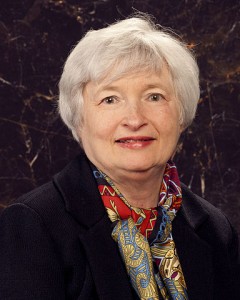Prior to officially becoming head of the most powerful system in the world, the Federal Reserve, there were numerous warnings that she would not reverse the $10 to $20 billion taper talk and actually increase the central bank’s quantitative easing measures that were put into place by her predecessor, Ben Bernanke.
Earlier this week, Yellen declared at an official swearing-in ceremony that she will “do all that I can” to boost a weak United States economy, which she describes as having low inflation and high unemployment. With the unemployment rate inching upwards to 6.7 percent, does this mean she will mimic her former boss at new levels?
In January, former Texas Republican Congressman and three-time presidential candidate Ron Paul warned that Yellen will “be more excessive in creating money.” Of course, Paul doesn’t blame Yellen or Bernanke but rather the deeply flawed system that has been place for the past century.
“They’ve taken the interest rates down to zero, the only tool they have is printing money, creating money out of thin air, so there’s nothing left. And she believes in even doing more of it,” stated the founder of the Campaign For Liberty and the Ron Paul Institute.
 Peter Schiff, president of Euro Pacific Capital, has stated repeatedly since the summer that the Fed will not taper because the market relies on its monthly stimulus injection of $85 billion, which will now be $65 billion per month. Essentially, what Schiff means is that if you’re into binary options then you should be betting that stocks will go down soon because of the diminished stimulus that Wall Street depends on.
Peter Schiff, president of Euro Pacific Capital, has stated repeatedly since the summer that the Fed will not taper because the market relies on its monthly stimulus injection of $85 billion, which will now be $65 billion per month. Essentially, what Schiff means is that if you’re into binary options then you should be betting that stocks will go down soon because of the diminished stimulus that Wall Street depends on.
“What is Janet Yellen going to do to try to revive the economy? There’s only one thing she can do, and that’s print even more money,” explained Schiff, who believes the fundamentals of the U.S. economy are unsound.
During the House Financial Services Committee in February, Yellen reaffirmed her commitment to the current monetary policy strategy and noted that the present recovery in both the U.S. economy and labor market remains “far from complete.” Bloomberg News noted this week that Yellen is trying her hardest to ensure the market that there is very little difference between herself and Bernanke.
Although it does remain to be seen if she will or will not increase QE, she has been an ardent supporter of the measures taken since the Great Recession. She, much like Bernanke, even confirmed that if the unemployment rate dips to below 6.5 percent then the Fed would still not relax its zero-interest-rate policy – instead she will likely be offering a qualitative guidance on the central bank’s future plans.
Investors and Fed presidents project interest rates will likely rise next year.
A survey of 40 economists completed in the middle of last year found that most believe the Fed will slash its monthly QE to $25 billion by July and end it completely in October. However, it should be noted that interest rate projections have continually been projected to rise every year without actually having never to do so.
Economists have already uttered their concern of yet another “taper tantrum,” something that took place last year. Michael Feroli, the chief U.S. economist at New York-based JPMorgan Chase & Co. and former Fed economist, told policymakers last week that volatility and instability in the market is likely to make an appearance again.
Marc Faber, a contrarian investor and publisher of The Gloom, Boom & Doom Report, thinks Yellen could very well enhance QE to $1 trillion and blow the asset bubble even more than what the Fed is doing now.
“The question is not tapering. The question is at what point will they increase the asset purchases to say $150 [billion], $200 [billion], a trillion dollars a month,” Faber told CNBC in October. “The quantitative easing is wind at the back of the economy. But when they unwind the quantitative easing, which they will ultimately have to do, it will be wind in the face of the economy. And then it won’t be so much fun.”
Whether it happens or not remains to be seen, but with Yellen at the helm and espousing the benefits of its $4 trillion balance sheet – projected to be $6 trillion by the end of President Obama’s term – it has left many in disbelief.



